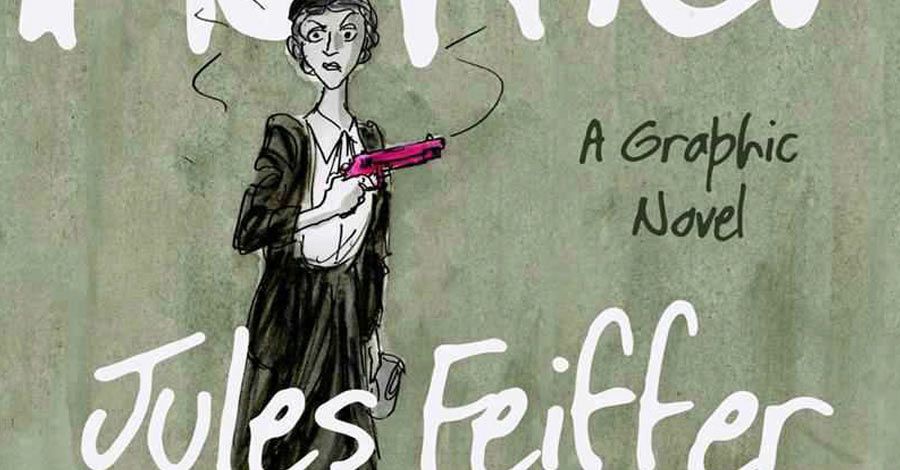The Comic-Con International panel on Jules Feiffer's upcoming noir graphic novel "Kill My Mother" began with a sad announcement. The legendary cartoonist/Oscar- and Pulitzer-winner had not made the trip to San Diego due to health reasons. But there was some unexpected good news revealed at the panel: Feiffer isn't planning on slowing down with his comics output, and is planning two more books that will follow the August release of "Kill My Mother."
On the panel were comics historians Mark Evanier and Paul Levitz, along with Will Menaker from W.W. Norton, publisher of Feiffer's latest. Levitz made the announcement that Feiffer wouldn't be attending to a disappointed audience. Then Levitz talked about first visiting Feiffer for an interview as part of the book he's working on about Will Eisner, and that's where he was shown Feiffer's new noir graphic novel. Levitz said it was a synthesis he had never seen before, and so he pushed Feiffer to attend New York Comic-Con last year to talk about it, admitting he wasn't as lucky getting him to San Diego when Feiffer announced he was dealing with pre-pneumonia symptoms.
Menaker said in talking to Feiffer, more than anything "Kill My Mother" represents "a discovery, late in life, late in his career, of the graphic novel format, and how in this his discovery of that, it really brings together almost every strand of his storied career -- from comics, cartooning, screenwriting, playwriting -- together in one package.
"He's taken all the threads of his career and woven them into 'Kill My Mother.' This really represents it all coming full-circle," said Menaker.
Menaker then talked about Feiffer's early influences, working as an apprentice for Will Eisner, and the adventure cartoons he read as a youth, notably Milton Caniff. "He mentioned one example of a single strip that to this day stands out in his mind like a diamond: 'Terry and the Pirates,'" said Menaker, citing the October 1941 Sunday edition where Raven Sherman dies. "Those 11 panels in full-color," according to Feiffer, "are the single greatest achievement in the comics medium not only because of how they use words and pictures, but also because of the way it uses silences."
Menaker also explained that for "Kill My Mother," Feiffer was essentially re-teaching himself to draw, and was watching a lot of Turner Classic Movies ("with a nice glass of whiskey," he hoped) to reference interiors and exteriors for his noir crime tale. For the story's third act, which takes place in the WW II's Pacific Theater, Feiffer worked from Roy Crane's "Captain Easy" for reference.
Preview copies of the book were then distributed around the room for the audience to flip through as the panelists talked about Feiffer's career and evolution as a cartoonist and writer, starting with his time as an apprentice for Will Eisner on "The Spirit," to his Village Voice strip "Sick, Sick, Sick," and on to "Tantrum," one of the first books to help launch graphic novels as a respectable medium.
Evanier talked about Feiffer's "The Great Comic Book Heroes," which reprinted older comics along with essays from Feiffer causing "an eruption in the industry." Evanier said a large excerpt mentioning Bill Everett ran in "Playboy," and Everett -- who was long and forgotten in the industry at that time -- was elated to hear he was called a genius in it.
"There was an importance for that book that should not be underestimated," explained Evanier. "For one thing, it was the first place a lot of people heard about 'The Spirit' in quite some time."
Evanier called the book "kind of an antidote to Fredrick Wertham's book," and explained part of the importance of Feiffer book tied to his cultural status at the time. He was a darling of the political left who got out of comics but didn't hide that that was where he came from, explained Levitz and Evanier.
"I think the industry changed a lot because of that book," said Evanier.
Levitz turned the panel back to "Kill My Mother," and the varied accomplishments of Feiffer's creative life. "This is the work of someone who has lived in all of these worlds. He's had to figure out how to stage actors, he's had to figure out how work a camera to tell a story. He's written prose, he's created static illustration," said Levitz, "and he's pulling all those skills together at this point in his career to try and find a new synthesis for storytelling."
The panel then remarked how rare it is that Feiffer came back to the medium still willing to experiment, resulting in another peak of innovation. They noted cartoonists typically have that breakthrough in the beginning of their careers. (Like Feiffer, Will Eisner was one cited by the panelists as having the two peaks of innovation, when he went from "The Spirit" and resurfaced with "A Contract With God.")
As the panel came to an end, Menaker announced news of Feiffer's plans to do two more books with the publisher, both set in the "Kill My Mother"-verse. The first draft of the second story -- called "Cousin Joseph" -- had already been written and takes place in 1931. It's a prequel that gives the full story of an unsolved murder of an honest cop that runs through "Kill My Mother." The third story will be called "Archie Goldman and the Decline of the West," and it will take place in Blacklist-era Hollywood.
"So this is an 83 year-old man who's mapped out the next four years of his life?" asked Evanier.
"Six," corrected Menaker.

